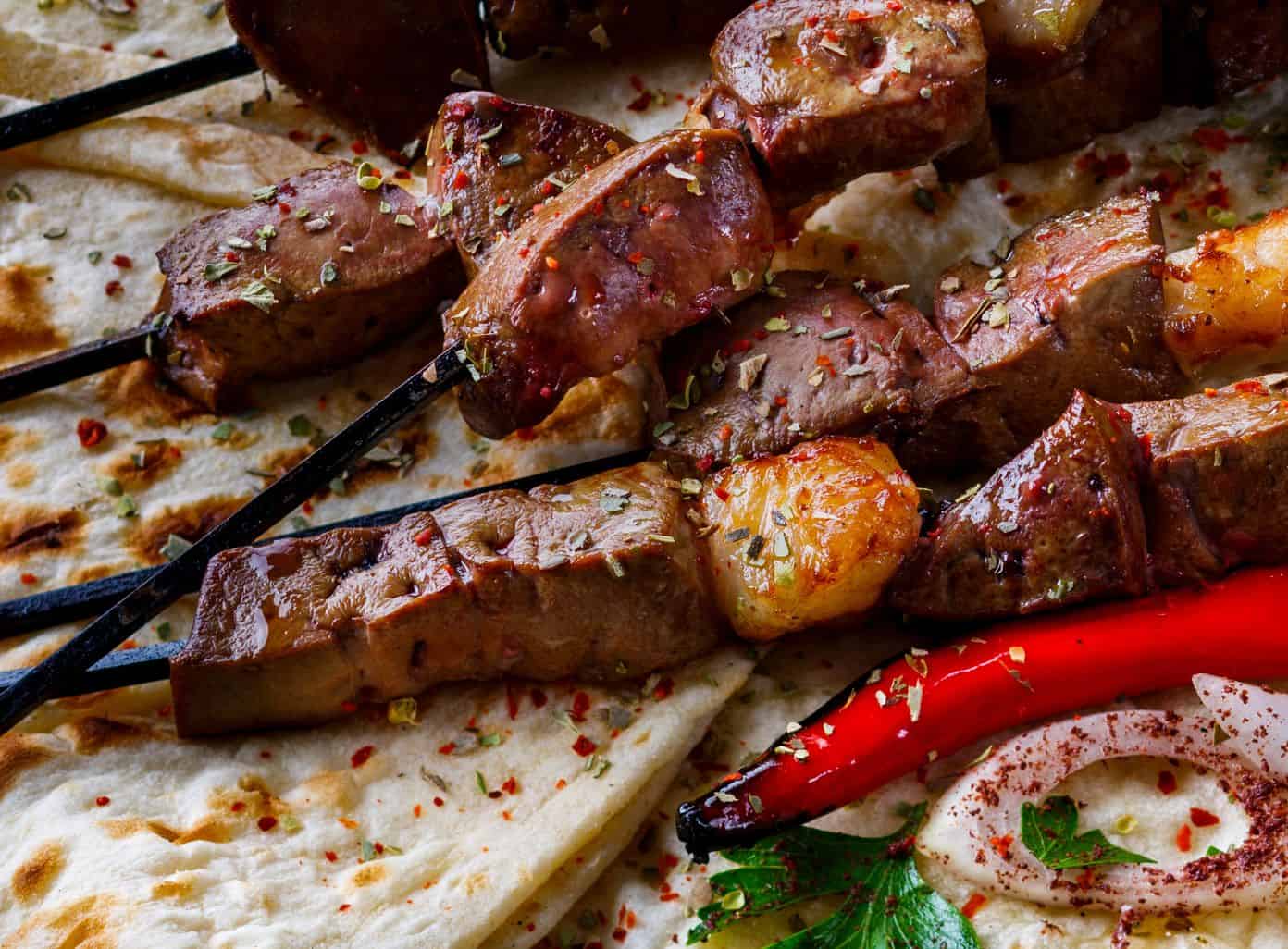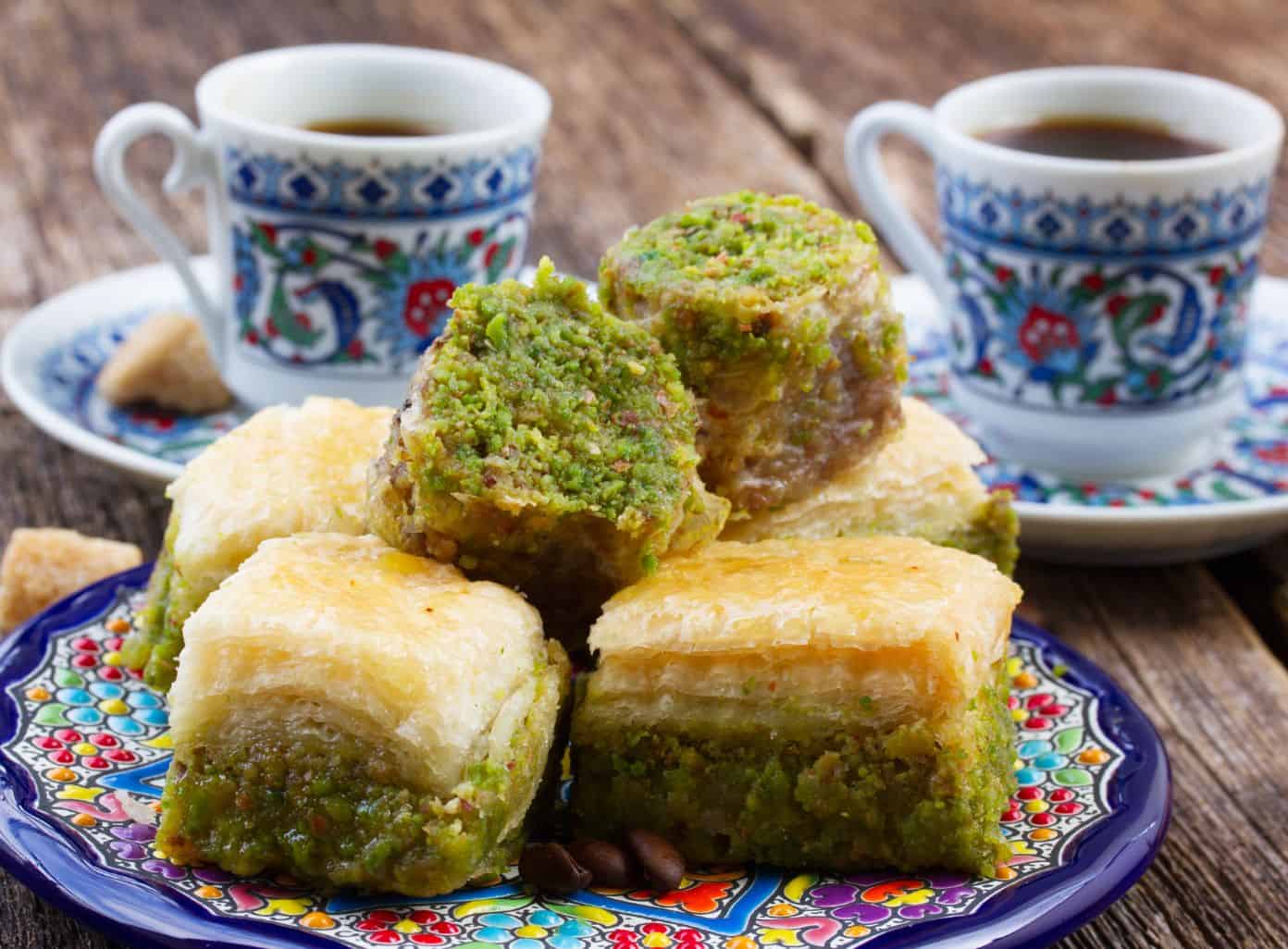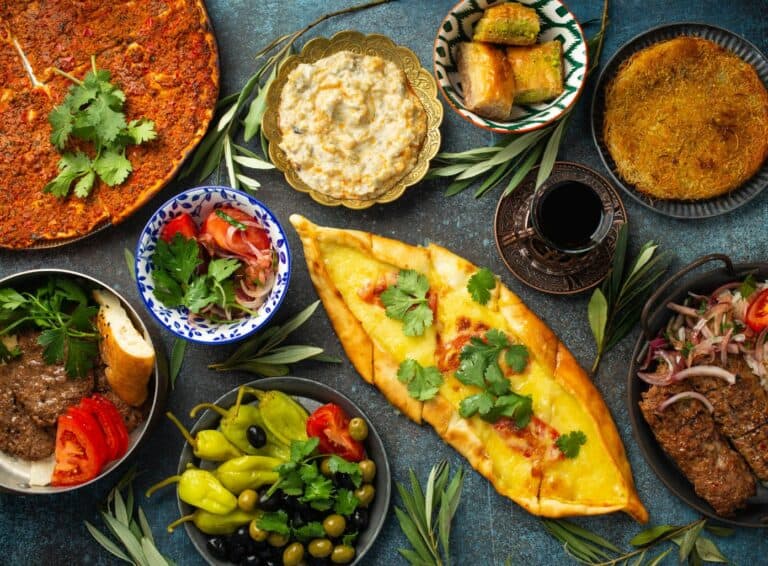Introduction to Turkish Cuisine
Turkish cuisine is renowned for its richness and diversity, offering a delightful culinary experience that reflects the country’s history, culture, and geographical location. With influences from various civilizations and regions, Turkish cuisine presents a fusion of flavors, ingredients, and cooking techniques that cater to a wide range of tastes.

Richness and Diversity of Turkish Cuisine
Turkish cuisine is a treasure trove of flavors, with a plethora of dishes to explore. From hearty kebabs and grilled meats to flavorful mezes and appetizers, the culinary landscape of Turkey is incredibly diverse. Each region of the country boasts its own specialties, influenced by local ingredients and traditions.
Turkish cuisine embraces a harmonious blend of ingredients, combining herbs, spices, fresh produce, and dairy products to create a symphony of flavors. The extensive use of aromatic spices and herbs adds depth and complexity to the dishes, tantalizing the taste buds and creating a unique culinary experience.
Cultural Significance of Food in Turkey
In Turkey, food holds immense cultural significance and is deeply intertwined with social gatherings, celebrations, and family traditions. Sharing a meal is not merely a means of sustenance but a way of connecting with others and expressing hospitality. Turkish people take great pride in their culinary heritage and often use food as a way to showcase their culture and traditions to visitors.
Hospitality is a cornerstone of Turkish culture, and guests are treated with utmost respect and generosity. Visitors to Turkey can expect to be greeted with warm hospitality, and food plays a central role in this hospitality. Traditional Turkish meals are often elaborate and include a variety of dishes, allowing guests to savor the richness of the cuisine and experience the true essence of Turkish culture.
As you explore the world of Turkish cuisine, you will discover the unique flavors, ingredients, and cooking techniques that make it a truly remarkable culinary journey. From the bustling streets of Istanbul to the coastal regions and beyond, each bite will transport you to a world of delectable flavors and vibrant culinary traditions.
To learn more about specific Turkish dishes and their preparation, continue to our section on traditional Turkish dishes.

Traditional Turkish Dishes
When it comes to traditional Turkish cuisine, there is a wide array of mouthwatering dishes to explore. From flavorful kebabs to delectable pastries, Turkish cuisine offers a culinary journey full of rich and diverse flavors. Here are some of the must-try traditional dishes:
Kebabs and Grilled Meats
Turkish kebabs are renowned worldwide for their succulent flavors. Whether it’s the popular döner kebab, tender shish kebab, or juicy Adana kebab, these grilled meat dishes are a staple of Turkish cuisine. The meat, often lamb or chicken, is marinated in a blend of spices and grilled to perfection, resulting in a smoky and savory delight. Kebabs are commonly enjoyed with fragrant rice or wrapped in warm flatbread.
Mezes and Appetizers
Turkish cuisine is known for its wide selection of mezes, which are small appetizer dishes bursting with flavor. Mezes offer a variety of tastes and textures, including refreshing salads, creamy dips like hummus and tzatziki, stuffed vine leaves known as dolma, and savory pastries like börek. These mezes are perfect for sharing and provide a delightful start to a Turkish meal.
Pide and Lahmacun
Pide and Lahmacun are popular Turkish flatbreads that make for satisfying meals. Pide is a boat-shaped bread topped with various ingredients such as cheese, minced meat, and vegetables. It is often enjoyed with a cracked egg on top. Lahmacun, on the other hand, is a thin and crispy flatbread topped with a flavorful mixture of minced meat, onions, tomatoes, and herbs. Both pide and lahmacun are commonly rolled up and eaten as street food.
Börek and Pastries
Börek is a beloved Turkish pastry made with thin layers of dough filled with a variety of ingredients such as cheese, spinach, or minced meat. These pastries are then baked or fried to golden perfection. Börek can be enjoyed as a savory snack or as a part of a meal. The flaky layers and savory fillings make it a delightful treat for any time of the day.
Pilaf and Rice Dishes
Rice holds a special place in Turkish cuisine, and pilaf dishes are a testament to that. Turkish pilaf is cooked with butter or olive oil and seasoned with aromatic spices like cinnamon, cumin, and saffron. It is often mixed with ingredients like vermicelli, peas, or nuts to add texture and flavor. Pilaf is a versatile dish that can be served as a side or as a main course with additions like chicken or lamb.
These traditional Turkish dishes are just a glimpse into the rich culinary heritage of Turkey. Exploring the flavors and ingredients of Turkish cuisine is an exciting journey that will leave you savoring the richness and diversity of this gastronomic wonderland.
Flavors and Ingredients
Turkish cuisine is renowned for its rich and vibrant flavors, which come from a variety of essential spices, herbs, fresh produce, and unique cooking techniques. Whether you’re exploring traditional dishes or modern interpretations, the flavors and ingredients used in Turkish cuisine are sure to tantalize your taste buds.
Essential Spices and Herbs
Spices and herbs play a fundamental role in Turkish cuisine, adding depth, aroma, and complexity to dishes. Some of the essential spices and herbs used include:
- Sumac: Known for its tangy and citrusy flavor, sumac is often used as a finishing touch on dishes like kebabs or salads.
- Cumin: This warm and earthy spice is commonly used in meat dishes, stews, and pilafs.
- Paprika: With its mild and slightly sweet flavor, paprika adds a vibrant red color and rich smokiness to dishes.
- Mint: Mint is a refreshing herb used in salads, yogurt-based sauces, and drinks like traditional Turkish tea.
- Oregano: Oregano is a staple herb in Turkish cuisine, used in various dishes, including grilled meats and tomato-based sauces.
- Parsley: Parsley is a versatile herb used as a garnish and flavor enhancer in many Turkish dishes, such as mezes and soups.
These are just a few examples of the wide range of spices and herbs used in Turkish cuisine. The combination of these flavors creates a unique and delightful culinary experience.
Fresh Produce and Vegetables
Turkish cuisine celebrates the abundance of fresh produce and vegetables, which are used in a variety of dishes. Locally sourced and seasonal ingredients are highly valued, ensuring that dishes are not only flavorful but also nutritious. Some commonly used vegetables include:
- Eggplant: Eggplant is a versatile vegetable used in many Turkish dishes, such as Imam Bayildi (stuffed eggplant) and Moutabal (smoky eggplant dip).
- Tomatoes: Tomatoes are a staple in Turkish cuisine, used in salads, stews, sauces, and as a garnish.
- Bell Peppers: Bell peppers add vibrant colors and a sweet, slightly tangy flavor to dishes like dolmas (stuffed vegetables) and roasted pepper dips.
- Zucchini: Zucchini is often used in Turkish cuisine, whether in soups, stews, or in the popular dish, “Mücver” (zucchini fritters).
- Spinach: Spinach is a common ingredient in Turkish cuisine, used in dishes like “Ispanaklı Börek” (spinach pastry) and “Pazı Sarması” (stuffed chard leaves).
These fresh vegetables not only provide essential nutrients but also contribute to the overall flavors and textures of Turkish dishes.
Use of Olive Oil and Dairy Products
Olive oil and dairy products are integral components of Turkish cuisine, adding richness and depth to various dishes. Olive oil is used generously in salads, dressings, marinades, and as a finishing touch on many dishes. Its fruity and slightly peppery flavor enhances the overall taste profile.
Dairy products like yogurt and cheese are also widely used in Turkish cuisine. Yogurt is a staple ingredient, providing a creamy and tangy element to dishes like kebabs, sauces, and mezes. Turkish cheese varieties, such as Feta and Kasar, are enjoyed in various forms, including as a standalone snack or as a key ingredient in dishes like börek (pastries) and pide (Turkish pizza).
The use of olive oil and dairy products showcases the Mediterranean influence on Turkish cuisine, creating a harmonious balance of flavors and textures.
By incorporating these essential spices, herbs, fresh produce, olive oil, and dairy products, Turkish cuisine captures the essence of its rich culinary heritage. The flavors and ingredients come together to create a vibrant and diverse gastronomic experience that should not be missed while exploring the delights of Turkey.
Regional Variations in Turkish Cuisine
Turkish cuisine is renowned for its diverse flavors and regional variations. Each region within Turkey has its own unique culinary traditions, influenced by local ingredients, cultural heritage, and historical influences. Let’s explore some of the distinctive regional cuisines in Turkey:
The Culinary Traditions of Istanbul
As the cultural and historical heart of Turkey, Istanbul offers a melting pot of flavors from various regions. Its cuisine reflects the influence of Ottoman, Byzantine, and Mediterranean cultures. Istanbul is known for its rich and hearty dishes, such as Istanbul köfte (meatballs), lahmacun (thin dough topped with minced meat and vegetables), and pilav (rice dishes). The city is also famous for its diverse street food culture, with iconic dishes like balık ekmek (grilled fish sandwich) and simit (sesame-covered bread rings). To experience the culinary delights of Istanbul, make sure to visit the bustling food markets and try traditional dishes at local restaurants. Check out our article on turkey markets to learn more about the vibrant food scene in Istanbul.
Unique Tastes from the Aegean and Mediterranean
The Aegean and Mediterranean regions of Turkey boast a cuisine that celebrates the bountiful produce of the land and sea. Fresh vegetables, herbs, and seafood take center stage in this region’s dishes. Popular Aegean and Mediterranean dishes include meze (assorted appetizers), grilled fish, kebabs, and dolma (stuffed vegetables). Olive oil is a staple in this region, and it is used liberally in salads, dressings, and dishes like imam bayildi (stuffed eggplant). The Aegean and Mediterranean regions are also known for their delicious desserts, such as baklava (layered pastry with nuts and syrup) and şekerpare (sugar cookies soaked in syrup).
Bold Flavors of Eastern Anatolia
Eastern Anatolia is characterized by its rugged landscapes and harsh climate, which have influenced the region’s robust and hearty cuisine. The cuisine of Eastern Anatolia features a variety of meat dishes, including succulent lamb and beef preparations. Kebabs and pilaf are popular in this region, often flavored with aromatic spices like cumin and sumac. Traditional dishes like çiğ köfte (raw meatballs) and katmer (layered pastry) are also beloved in Eastern Anatolia. The region’s cuisine showcases the use of unique ingredients like kemik suyu (bone broth) and tarhana (fermented grain and yogurt soup). To experience the bold flavors of Eastern Anatolia, be sure to try the local specialties when visiting this region of Turkey.
Delicacies of the Black Sea Region
The Black Sea region is known for its vibrant green landscapes and a cuisine that highlights the abundance of fish, corn, and tea. Fish dishes play a prominent role in the region’s cuisine, with hamsi (anchovy) being a local favorite. The Black Sea region is also famous for its corn-based dishes, such as mısır ekmeği (cornbread) and mıhlama (a cornmeal and cheese dish). Tea is an integral part of daily life in the Black Sea region, and it is often enjoyed with local delicacies like karadeniz pidesi (Black Sea-style flatbread) and kuymak (a cheesy cornmeal dish). Exploring the culinary delights of the Black Sea region is a must for any food enthusiast visiting Turkey.
By exploring the regional variations in Turkish cuisine, you can immerse yourself in the rich culinary heritage of the country. Each region offers its own unique flavors, ingredients, and traditional dishes. Whether you’re in Istanbul, the Aegean and Mediterranean coastal areas, Eastern Anatolia, or the Black Sea region, be sure to savor the delights of Turkish cuisine.
Turkish Beverages and Desserts
No exploration of Turkish cuisine is complete without indulging in the delightful Turkish beverages and desserts. These offerings bring a unique and satisfying end to any meal and are deeply ingrained in Turkish culinary culture. Let’s dive into the world of traditional Turkish tea, Turkish coffee, and a variety of sweets and desserts.
Traditional Turkish Tea
Traditional Turkish tea, also known as çay, holds a special place in Turkish culture. It is a staple beverage that is enjoyed throughout the day, from breakfast to after-dinner conversations. Turkish tea is typically brewed using a double teapot called a çaydanlık, where water is boiled in the lower pot and loose black tea leaves are steeped in the upper pot. The tea is then served in small tulip-shaped glasses, often accompanied by a sugar cube or two.
Turkish tea is known for its strong and robust flavor, making it a perfect companion for conversations and social gatherings. It is often sipped slowly, allowing the warmth and aroma to be savored. You can find tea houses, known as çay bahçesi, and street vendors offering freshly brewed tea in almost every corner of Turkey. Exploring the vibrant tea culture is a must for visitors to truly experience Turkish hospitality.
Turkish Coffee
Another iconic beverage in Turkish cuisine is Turkish coffee. This rich and aromatic brew is prepared using finely ground coffee beans and brewed in a small pot called a cezve. The coffee is typically served in small cups, accompanied by a glass of water to cleanse the palate.
Turkish coffee is known for its strong flavor and thick, velvety texture. It is traditionally prepared with sugar, but you can also request it unsweetened or specify your desired sweetness level. Drinking Turkish coffee is an experience in itself, as it is often accompanied by fortune-telling using the coffee grounds left at the bottom of the cup. This ancient tradition adds an element of intrigue and excitement to the coffee-drinking experience.
Sweets and Desserts
Turkish cuisine boasts an impressive array of sweets and desserts, each offering a unique burst of flavors and textures. From traditional pastries to syrup-soaked delights, there is something to satisfy every sweet tooth.
One popular Turkish dessert is baklava, a delicate pastry made of layers of paper-thin phyllo dough filled with a sweet mixture of ground nuts, sugar, and spices. The layers are then baked until golden and crispy before being drenched in a fragrant syrup made with honey, lemon juice, and rosewater. Baklava is a true indulgence and a must-try for dessert enthusiasts.
Another beloved sweet treat is lokum, more commonly known as Turkish delight. This gel-like confection is made by thickening a mixture of sugar, water, and starch, then flavored with a variety of ingredients such as rosewater, lemon, or nuts. Lokum comes in a myriad of flavors and colors, making it a delightful treat for both the eyes and the taste buds.
To truly appreciate the diverse range of Turkish sweets and desserts, consider visiting local pastry shops and markets, where you’ll find an abundance of options to satisfy your cravings.
Turkish beverages and desserts are an integral part of Turkish culinary culture, providing a delightful ending to any meal. Whether you’re sipping on traditional Turkish tea, savoring a cup of Turkish coffee, or indulging in a variety of sweets and desserts, these culinary delights will leave you with a sweet and lasting impression of the richness of Turkish cuisine.
Exploring Turkish Cuisine: Restaurants and Street Food
When it comes to experiencing the vibrant flavors of Turkish cuisine, exploring the local restaurants and indulging in street food is a must. Turkey offers a diverse range of culinary delights that reflect its rich cultural heritage and regional influences. In this section, we will explore popular Turkish restaurants and highlight some must-try street food options.
Popular Turkish Restaurants
Turkey is home to numerous restaurants that showcase the best of Turkish cuisine. From traditional eateries to modern establishments, there is something to suit every palate. Here are some popular Turkish restaurants worth visiting:
| Restaurant Name | Location | Specialties |
|---|---|---|
| Meyhane | Istanbul | Mezes, grilled kebabs, raki |
| Karaköy Lokantası | Istanbul | Turkish comfort food, stews, seafood |
| Ciya Sofrası | Istanbul | Anatolian cuisine, regional specialties |
| Asitane | Istanbul | Ottoman cuisine, historical recipes |
| Zübeyir Ocakbaşı | Istanbul | Authentic Turkish kebabs, grilled meats |
| Mikla | Istanbul | Contemporary Turkish cuisine, rooftop dining |
| Antiochia | Antakya | Antakya cuisine, mezes, traditional dishes |
| Çiya Sofrası | Kadıköy | Regional Anatolian cuisine, vegetarian options |
These restaurants offer a diverse range of dishes, allowing you to sample the flavors of different regions within Turkey. Be sure to check their opening hours and make reservations in advance, especially during peak tourist seasons.
Must-Try Street Food in Turkey
Exploring the streets of Turkey is an adventure for the senses, with an array of tantalizing street food options to tempt your taste buds. Here are some must-try street foods that you shouldn’t miss:
| Street Food | Description |
|---|---|
| Simit | A circular bread covered in sesame seeds, often enjoyed with tea for breakfast or as a snack. |
| Döner Kebab | Thinly sliced marinated meat, usually lamb or chicken, cooked on a vertical rotisserie and served in a pita bread or wrap. |
| Balık Ekmek | Grilled fish, typically mackerel or sea bass, served in a bread roll with salad and a squeeze of lemon. A popular street food option in coastal cities like Istanbul and Antalya. |
| Midye Dolma | Stuffed mussels filled with a flavorful rice mixture, often served with a squeeze of lemon. |
| Lahmacun | Thin and crispy flatbread topped with minced meat, onions, and a variety of herbs and spices. |
| Simit Sarayı | A chain of bakeries offering a variety of baked goods, including simit, pastries, and sandwiches. |
| Kumpir | Baked potato stuffed with various toppings like cheese, butter, olives, corn, and more. |
| Gözleme | Thin dough filled with a savory mixture of cheese, spinach, potatoes, or meat, folded and cooked on a griddle. |
| Mısır | Grilled or boiled corn on the cob, typically seasoned with salt and served with a squeeze of lemon. |
| Tantuni | Thinly sliced beef or lamb cooked with spices, wrapped in a flatbread, and served with salad and a squeeze of lemon. |
These street food options offer a glimpse into the culinary culture of Turkey and are perfect for those looking to savor the local flavors while exploring the bustling streets. Remember to sample street food from trusted vendors and follow hygiene practices to ensure a safe and enjoyable experience.
Whether you choose to dine at a popular Turkish restaurant or indulge in the flavors of street food, Turkish cuisine promises a delightful journey for your taste buds. Embrace the richness and diversity of Turkish flavors as you explore the culinary wonders this beautiful country has to offer.


